Starting a food blog can be a very fun, rewarding, and even profitable experience—as long as you’re ready to put in the time, and effort and truly learn how to start a food blog (the smart way) and set it up for maximum growth potential.
You’re starting a food blog to eventually position yourself as an expert and thought leader within your niche—and before you know it, this new site could open doors to unexpected mouth-watering opportunities like book deals, television appearances, cooking product lines and so much more.
And get this, even if you just want to be a hobby food blogger, you can still make your new blog very profitable.
The best part? You don’t need any coding or technical blogging skills—or even much of a financial investment to start food blogging today.
So, if you’re ready to learn how to start a food blog that actually makes money, then this guide is for you.
How to Start a Food Blog in 8 Easy Steps (in 2025)
- Choose your food blog niche
- Pick a catchy name for your blog
- Get your food blog online (web hosting)
- Design your food blog with free tools and templates
- Create the main pages of your food blog
- Plan your food blog content strategy and positioning
- Nail your images (the best food blogs have great photography)
- Promote your food blog and network with other food bloggers
In this guide to starting a food blog, we’re going to walk through the eight steps of how to start a food blog—backed by my interviews with some of the world’s most successful food bloggers.
Disclosure: Please note that some of the links below are affiliate links and at no additional cost to you, I may earn a commission. When you purchase web hosting using one of my affiliate links, I’m compensated, which helps make this content free of charge to you. Know that I only recommend products and services I’ve personally used and stand behind.
Create SEO Blog Posts in Minutes with RightBlogger
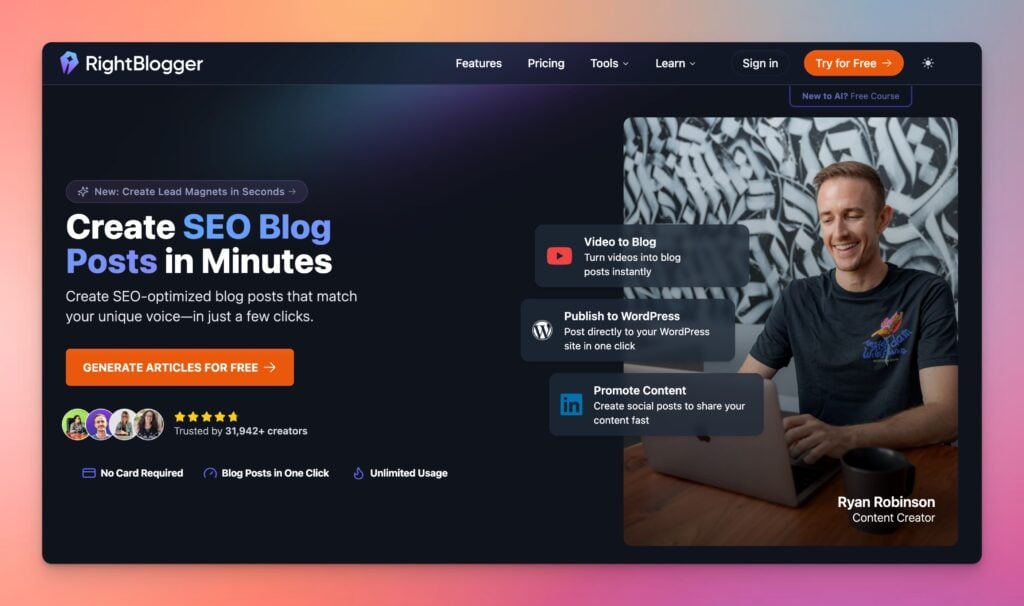
Join 31,942+ creators, bloggers, marketers, writers, freelancers & entrepreneurs in using my very own kit of powerful tools for content creation: RightBlogger. You’ll unlock 80+ blogging, SEO, marketing, sales and productivity-focused tools to create content faster & more effectively today. Plus, you’ll access our library of high-impact courses, a private community, and more.
Now, let’s dive into my ultimate guide on how to start a food blog.
1. Choose your food blog niche
Food blogging is a very broad topic area if left this generalized.
You may already know exactly which aspect you want to focus your food blog around, but it’s important to start by really sharpening your angle & message. The realm of tasty calorie-smart recipes has so many facets, that deciding where to begin can be a bit daunting. Thankfully, with so many options to choose from, brainstorming fresh content for your blog shouldn’t be a challenge.
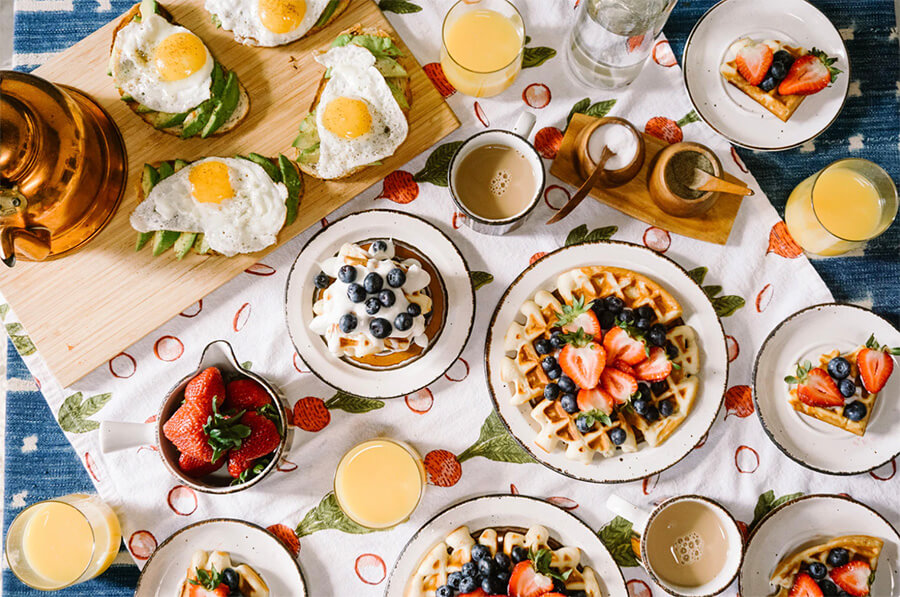
Either way, having a specific niche when you start a food blog, will keep you focused and make it easier for you to:
- Identify and understand your target readers (i.e. who are the people that’ll most love my content?)
- Brand your food blog so it stands out from others (i.e. how is my food blog unique in my industry?)
- Grow and monetize your food blog (i.e. how will I make money blogging as a food blogger?)
Right, so let’s look at some different blog niches you can choose from within the overall food blogging industry (peep my list of niches for more ideas):
- Recipe food blog that’s focused on reviving old family recipes from around the world
- Specific diet food blog that discusses healthy, vegan, or gluten-free diet options—like Vegan Anj where she breaks down topics like creating a vegan grocery list)
- Food blog specializing in Indian dishes, Japanese meals, African dishes, or others from your cultural background
- Food blogs focused on cooking methods like baking, grilling, and so on
- Food photography blog that’s more about capturing amazing shots at top restaurants
Remember, it’s in your best interest to pick a niche that goes nicely with your own passions, interests, expertise, and personality when you start a food blog.
2. Pick a catchy name for your food blog
Picking the right name for your blog can make it stand out and quickly catch the attention of your target readers.
The right name for your food blog also communicates what your food blog is all about, your position in the industry, and even who your recipes are for—in mere seconds.
Take for example the clever, simple, and fun name of Gaby Dalkin’s food blog—What’s Gaby Cooking?
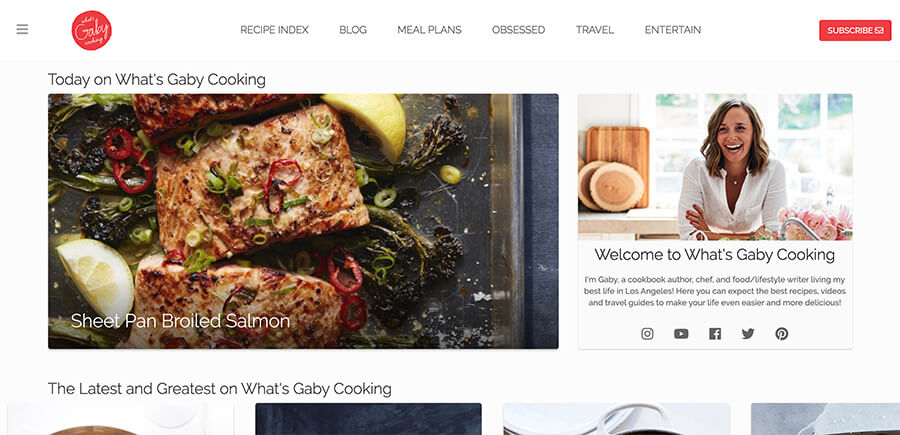
Your food blog’s name, also known as its domain name or blog URL—will be your blog’s address on the Internet.
This is what people will type into their web browser’s address bar in order to navigate straight to your food blog—or they could even search for its name on major search engines like Google. It’ll look like this right here (and you’ll usually want it to end in a .com):

While you definitely can start food blogging for free by using platforms like Medium, Tumblr, or Blogger (or even by just building up a following on Instagram first), it’s important to buy your own domain name—so that it belongs to you—in case you eventually want to build a business or earn an income from your food blog.
The free blogging sites of the world will severely restrict your capabilities when it comes to the design, features, functionalities, and ability to monetize your food blog.
Let’s pick the name (and domain name) for your food blog.
Here are a few quick tips to help you pick a catchy name for your food blog:
- Look closely at your niche and see if anything clever or punny comes to mind
- Consider your target audience and what might catch their attention
- Check out the names of other successful food blogs for inspiration
- Use a helpful keyword in your niche (to clearly indicate your positioning)
- Keep it short and easy to remember, pronounce, and spell
- Use domain name generators (like SmartWP’s Name Generator) if you’re stuck
- Use your own name, nickname, or a combination of your names (like Vegan Anj)
Even if you’re not quite sure what to name your food blog yet, let’s keep moving—you can always settle on a name later.
3. Get your food blog online (web hosting)
Your food blog needs to be hosted online by a web hosting company before you can do anything else (and make it visible on the Internet).
At this stage, we’ll also be deciding on the blogging platform you’ll use to actually start your food blog—alongside the web hosting plan you’ll use to get your food blog online.
The blogging platform that 95% of food bloggers use is called WordPress, and the web hosting company I recommend (to get your food blog online) is Bluehost.
WordPress is a publishing platform that’s been around for nearly two decades and currently hosts more than 34% of all websites on the Internet (including my blog right here). Bluehost is one of the most reputable, longest-standing hosting companies that bloggers use to get their websites online. This is the combination we’ll be using throughout the rest of this food blogging tutorial.
Disclosure: Please note that when you purchase web hosting using my Bluehost affiliate link, they compensate me, which helps me make this guide free of charge to you. Know that I also use Bluehost hosting, and I would never recommend a product, tool, or service I don’t personally use & advocate for 🙂
Now, let’s choose the name and hosting plan for your food blog.
—> Click here to go to Bluehost and then click the green “Get Started Now” button.
Choose your food blog hosting plan.
Next, you’ll select a hosting plan. I personally recommend choosing the Choice Plus plan (which I use)—because it comes with Domain Privacy, which will protect your personal information (your full name, email address, phone number, and home address) from being published anywhere online as the owner of your new food blog. With this plan, Bluehost will guard that information on your behalf.
Choosing your plan will look like this right here. Click the green “Select” button on your plan of choice:
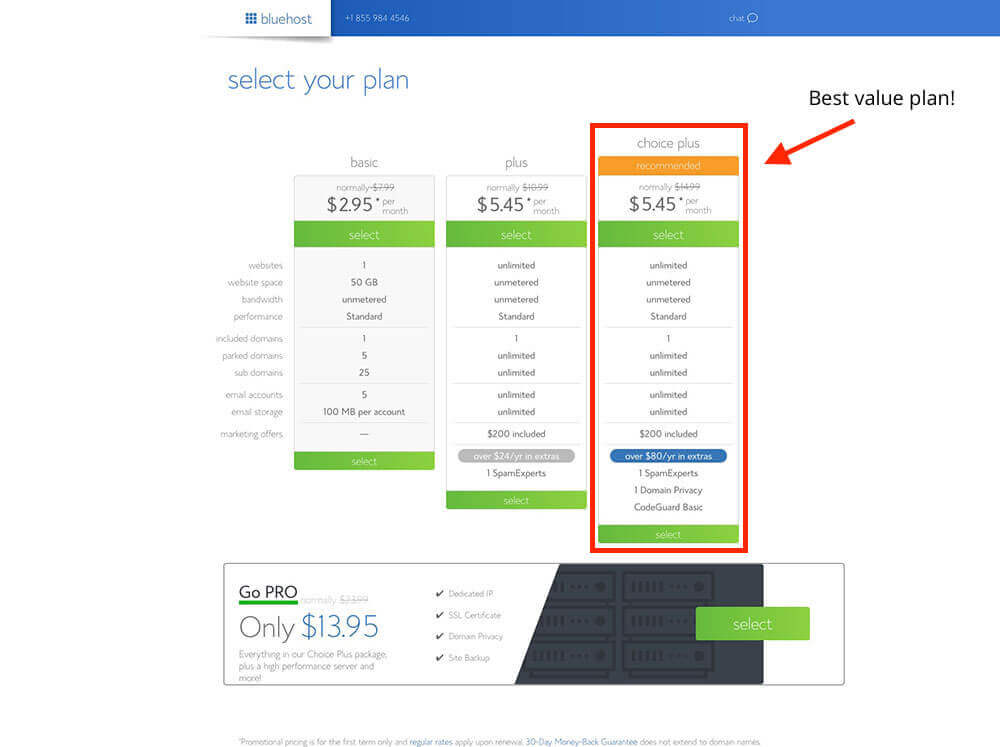
Secure your food blog’s domain name.
Next, you’ll get to choose the domain name you use for your food blog:
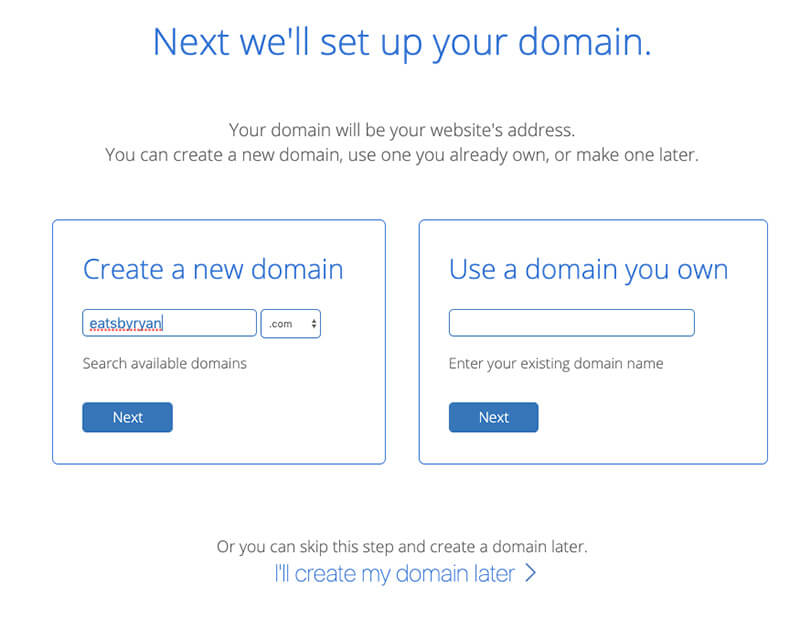
Just type in the food blog domain name you’d to register (like eatsbyryan.com).
If your food blog domain name of choice isn’t available, you can either try another option that comes to mind—or (what I recommend) select the option to choose your domain name later after getting the rest of your blogging details squared away and taking some more time to think the name through.
After either securing your food blog’s domain name (or opting to select it later), you’ll be taken to the final step—creating your account.
Create your Bluehost account.
Start by filling in your account details like your name, email address, and address until you’ve completed the form on this page:
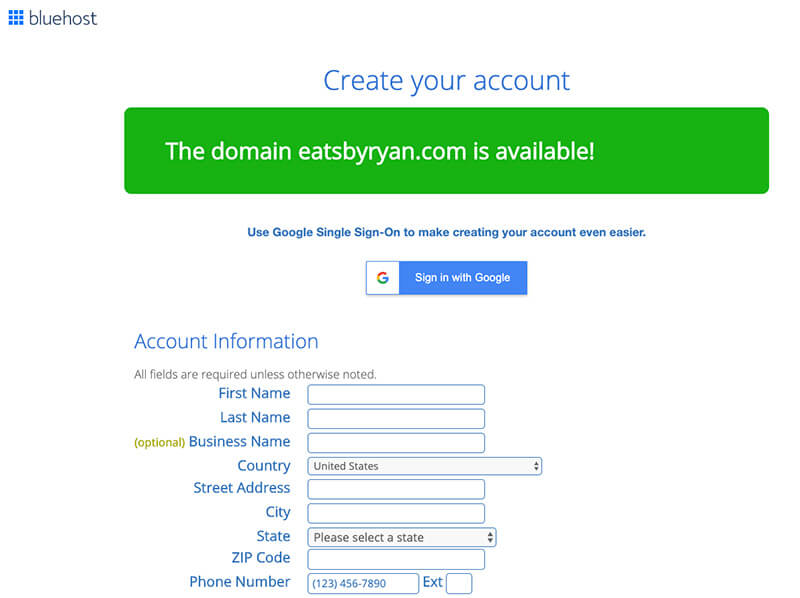
Select the right hosting package for you.
This is where you’ll choose an account plan based on the price you want to lock in and how far in advance you’ll pay for your hosting today.

Bluehost only offers options for you to pay 1, 2, 3, or 5 years upfront. They don’t offer a monthly payment plan (because most hosting companies that do offer monthly payments tend to charge more). With whichever plan you choose, the price still works out to be a good deal for getting your food blog online.
Which plan is best?
Personally, I recommend choosing the “Prime 36 Month Price” if you want to lock in the lowest possible price for your hosting. That’s what I use. It secures your blog hosting at their lowest rate (and gets you domain privacy) for the next 3 years.
Ultimately, I recommend going with the longest-duration plan that your budget can spring for.
The total you’ll now see is the amount you’re going to pay today. Remember, you won’t have to pay again for 1, 2, 3 or 5 years depending on the package you choose. Plus, there’s a 30-day money-back guarantee in case things don’t go as planned with your food blog.
Enter your billing information.
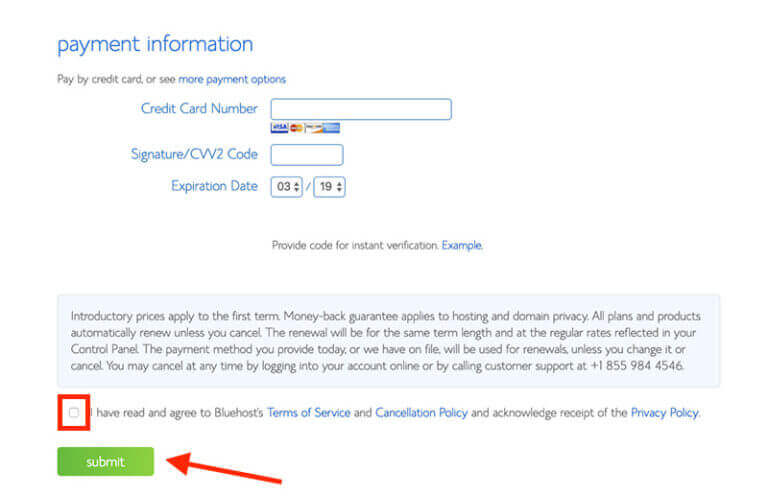
Now you’ll input your billing information, check the box that you agree to Bluehost’s Terms of Service, and then hit the green “Submit” button.
It’s time to party! You’ve completed the first major step of how to start a food blog! 🎉
With the initial signup process complete, it’s time to move into the next stage of getting your food blog fully set up.
—> Click here to head over to Bluehost and register your domain if you haven’t already.
On the next page, you’ll be guided step-by-step through the process of getting WordPress installed on your food blog through Bluehost. And if you want to evaluate some more options for hosting, check out my regularly updated list of the best web hosting plans on the market today.
4. Design your food blog with free tools & templates
At this point, you’ve now gotten your WordPress-powered blog installed and hosted on Bluehost.
It’s a blank slate for us to now make beautiful! And we’re going to do that using free tools & templates.
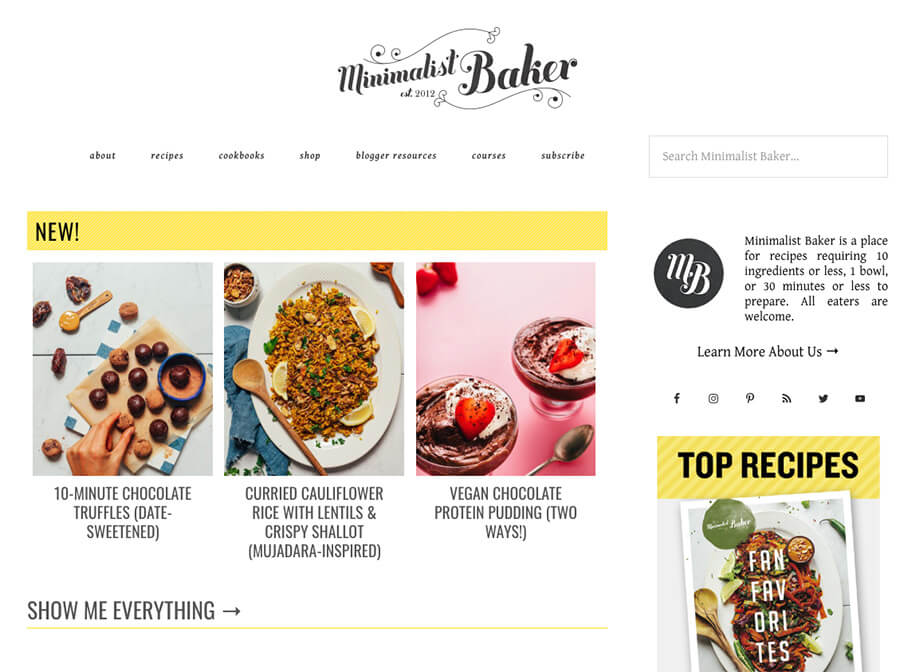
To achieve success when you start a food blog, not only must your food blog look attractive—it also needs to give your readers a fantastic user experience.
And that’s why the right food blog design is so important. Check out the Minimalist Baker‘s website for an example of a fantastic food blog layout.
The good news is that you can design your food blog and achieve wonderful results even by using free tools and WordPress themes. And we’re going to be walking through a few different categories of free resources to use in designing your food blog.
- A content management system (CMS)
- WordPress Themes
- WordPress Plugins
So, let’s take a closer look at each one.
Content Management System (CMS)
First, you need a content management system—also known as a blogging platform—so you can write blog posts, share photos and publish recipes or reviews on your food blog. Take some inspiration from my roundup of honest Bluehost reviews to see the different kinds of formats a review article can come in.
If you’ve followed along with our tutorial so far, then you’ve already chosen to use WordPress as your CMS. Great!
You’re in good company. Check out these amazing statistics about WordPress:
- WordPress is the most popular CMS for the seventh year in a row and holds a 50% to 60% share of the global CMS market
- WordPress is the fastest-growing CMS with roughly 500+ new blogs being launched daily on the platform
WordPress is search engine friendly (blog SEO), very simple to use, and allows you to organize your content strategically, and add video and images—while still giving you control over every design aspect of your blog. It’s also free to use (with the exception that you need to secure your own monthly web hosting plan) and it gives you the ability to easily add more features to your blog like forums, an online store, and even paid memberships from your readers.
Now, let’s talk themes.
WordPress themes for food bloggers
A WordPress theme is going to be your food blog’s behind-the-scenes “template” that controls the visual layout, look, and feel of everything on your food blog. Choosing the right WordPress theme that gives you the options you’ll need, therefore, is a very strategic decision.
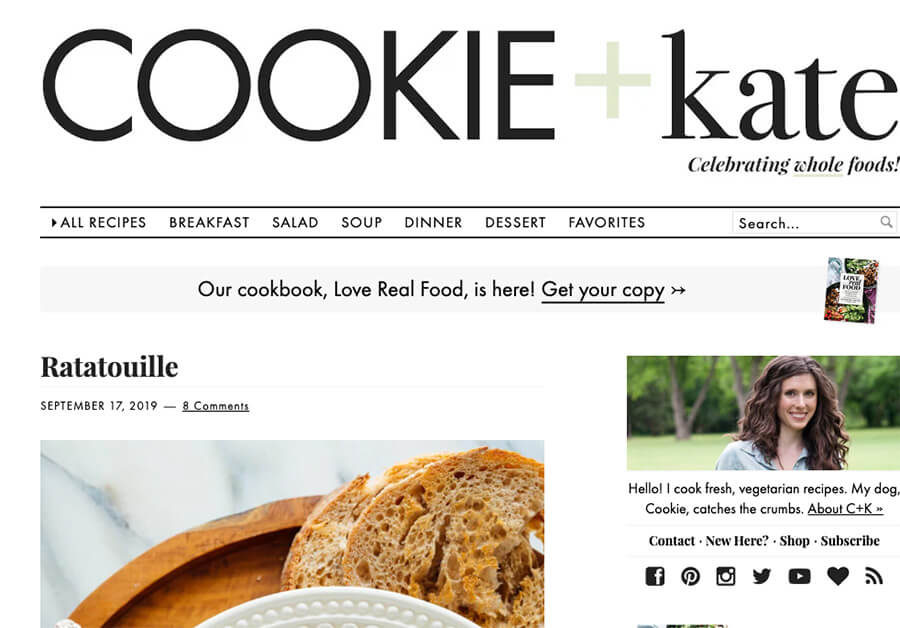
With WordPress as your CMS, you can customize and improve the look of your food blog by choosing a free WordPress theme to start out with—and worry about getting a more premium theme with additional features later on down the road once you’re getting some readers to your blog.
Like I said though, you should start your food blogging journey with as many free tools as possible.
Here’s my pick for the best free WordPress theme and page builder you should use when you’re just starting:
Elementor Page Builder + WordPress Theme (Free)
Elementor’s Page Builder paired with their free WordPress Theme is hands down the best combo for new food bloggers to get started with because these two working together allow you to design your entire food blog with a vast amount of customizability—without any coding knowledge—and to great effect with stunningly beautiful page layouts & designs. On top of that, the Hello Theme is also the fastest WordPress theme I’ve ever tested, so your site will load at lightning speed for your readers.
At the very center of this WordPress theme is the drag-and-drop visual page builder that’s designed to help you easily make a website and design it to suit your needs.
To get you started, it comes with a collection of diverse page templates, design elements, and various widgets that can help enable tons of core blogging features (like email capturing, clickable buttons, video embeds, scrollable Google Maps embeds, form submissions, and more).
You can truly design a fully functional food blog without any help—and they also have a vast library of tutorial articles & videos to help guide you through it. Here’s a sneak peek of what Elementor looks like behind the scenes:
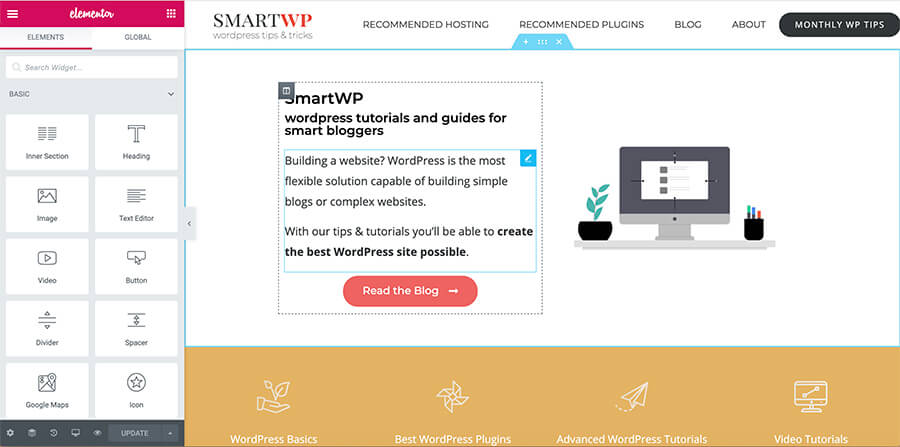
Did I mention it’s free?
If you want to create a relatively simple food blog layout (which is perfect if you’re just starting to blog), then the 100% free version of Elementor will do the trick. Once you’re ready to upgrade to Elementor Pro or evaluate other theme options, you’ll unlock an entirely new world of possibilities for designing a standout blog.
You can head over and get the free version of Elementor Page Builder here. Their free WordPress Theme is right there too so you can use the two together.
Once you’re ready to upgrade to a more robust theme, Kate of cookieandkate.com recommends using one of these two top (paid) food blogging WordPress themes:
Remember, to pick the right WordPress theme for your food blog, it’s important to keep these considerations in mind:
- Use a theme with a simple, clean, and straightforward design so your visitors can engage with your content easily and also move around your food blog without difficulty
- Pick a theme that makes your food blog look good on all devices whether it’s a laptop, desktop, tablet and mobile
- Make sure the theme works with all browsers and is optimized for SEO
- Ensure that the theme supports all popular plugins that your food blog needs
- Look for reviews and ratings to check the track record of the theme
Now, let’s examine the must-have WordPress plugins you’ll want to install right away to add some additional functionality to your food blog.
WordPress plugins for food bloggers
Because you’re using WordPress as your CMS, you can further improve the functionality of your food blog by using a range of free and paid plugins.
Simply put, a plugin is a small piece of software that can be added to your food blog to improve how it works and add new features without writing any form of code.
Similar to themes, there are lots of free and paid plugins available on the market. Here are a few of my favorite plugins you should consider installing on your food blog right away:
- Yoast SEO to optimize your food blog pages and articles to better rank in Google results
- WPForms to create easy forms (for email sign-ups, contact requests, etc)
- MonsterInsights for Google Analytics to gather insights about the readers coming in
- Perfmatters for speeding up your food blog and optimizing its code
- Jetpack for doing regular backups of your food blog
- RightBlogger to generate blog post ideas, headlines, outlines, and even full posts using AI—perfect for food bloggers who want to publish content faster without sacrificing quality
5. Create the main pages of your food blog
When visitors arrive on your food blog, it’s normal for them to have questions about your food blog.
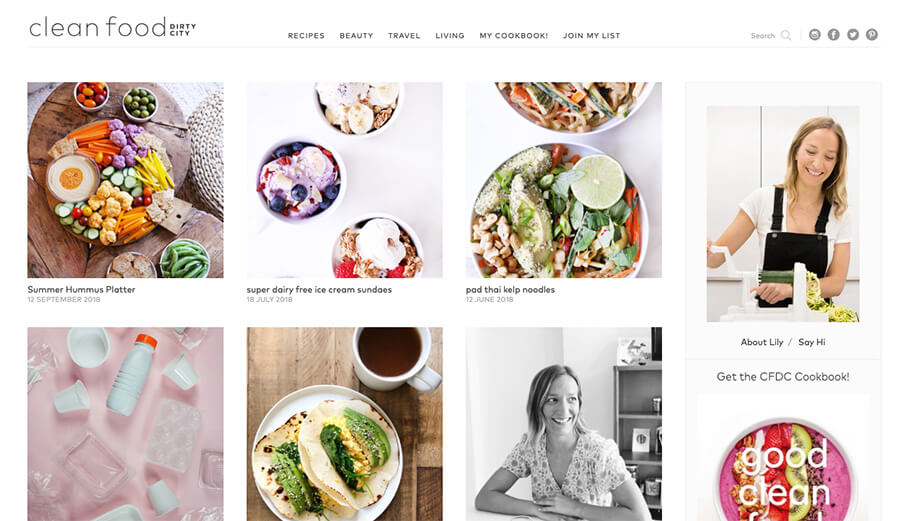
They’ll often wonder how it’s different from other food blogs in your space—and based on the layout of your site, will very quickly form an opinion of the person (or people) behind the food blog and whether or not your content will be for them. Take Lily’s homepage example from her food blog—Clean Food, Dirty City.
To answer these questions in advance for your readers, it’s important to create the main pages of your blog, especially these three:
- Homepage
- About page
- Contact page
The homepage of your food blog
In most cases, your food blog home page is going to be the first page visitors will find themselves after typing your blog name into a search engine, or discovering it from a guest blog post you’ve done for another food blogger—and your homepage should provide a detailed overview of the various sections of your food blog.
Take for example the homepage layout of Lindsay’s popular food blog, Pinch of Yum:
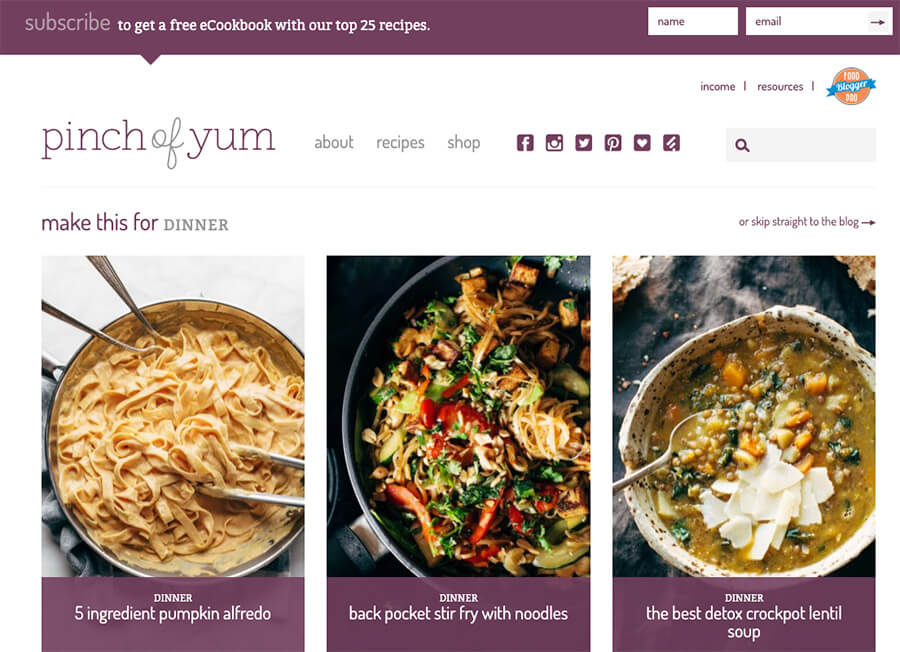
Keep in mind that your food blog home page elements should ideally include:
- A simple, clear headline that informs visitors what your food blog has to offer in less than 3 seconds
- A sub-headline that gives a short description of the value your food blog provides
- Calls to action that direct visitors to different areas of your food blog (where you want them to go)
- Stunning pictures that capture their attention and introduce them to your visual style
- Links to your best content so visitors can stay around longer
Need Catchy Blog Title Ideas?
Try my free AI-Powered Blog Title Generator Tool to get dozens of SEO-friendly headline ideas to make your blog posts stand out today.
The About Me page of your food blog
The About Me page on your food blog should not only introduce you and your message, it should also answer these key questions:
- Why should someone tune in and follow along with your food blog?
- What problems can you solve for readers of your food blog?
- How can you uniquely help your readers?
Take for example Beth’s about page on the popular food blog, Budget Bytes:
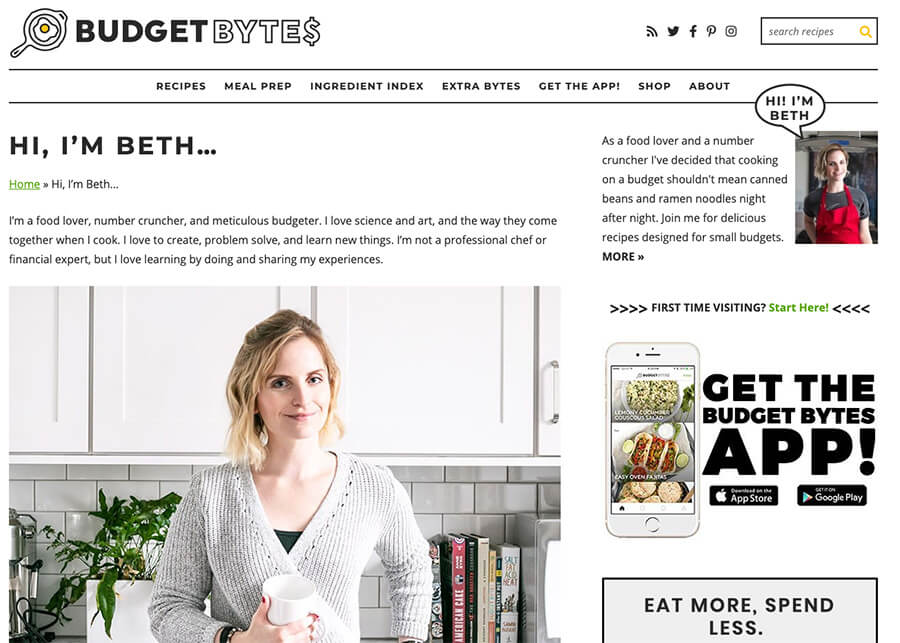
Start with my guide about how to write an About Me page for your blog—so that on your food blog’s About page, you’ll always remember to:
- State your name clearly and include a picture of yourself to build a stronger connection with readers
- Add any credentials and certifications you have to boost your credibility as a food blogger
- Write in your normal conversational voice, so readers can get a sense of your personality and feel like you’re speaking to them
- Make your story as engaging and relatable as possible
The contact page of your food blog
This page should be easy to find on your food blog and must provide information on how best to reach you, whether it’s for reader questions, to enquire about working with you, sponsoring your blog, or otherwise.
Your food blog contact page can be extremely simple. Take Katie’s example page from her blog—What Katie Ate:
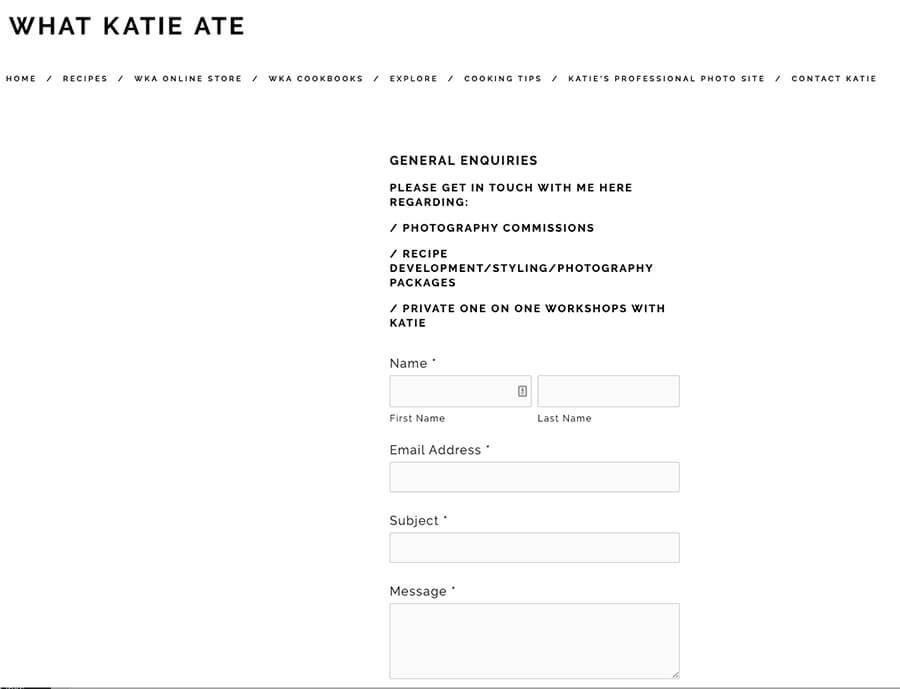
In essence, your contact page should contain these elements:
- Quick answers to questions readers frequently ask (or a link to a FAQ page)
- A short form that’s easy to understand and fill out based on their requests
- An email address to reach you at
- Links to your social media accounts (especially Instagram and Pinterest)
6. Plan your food blog content strategy and positioning
Without a content strategy to guide you, it can be easy to mix things up and start discussing blog topic ideas that aren’t relevant to your niche or audience when you start a food blog.
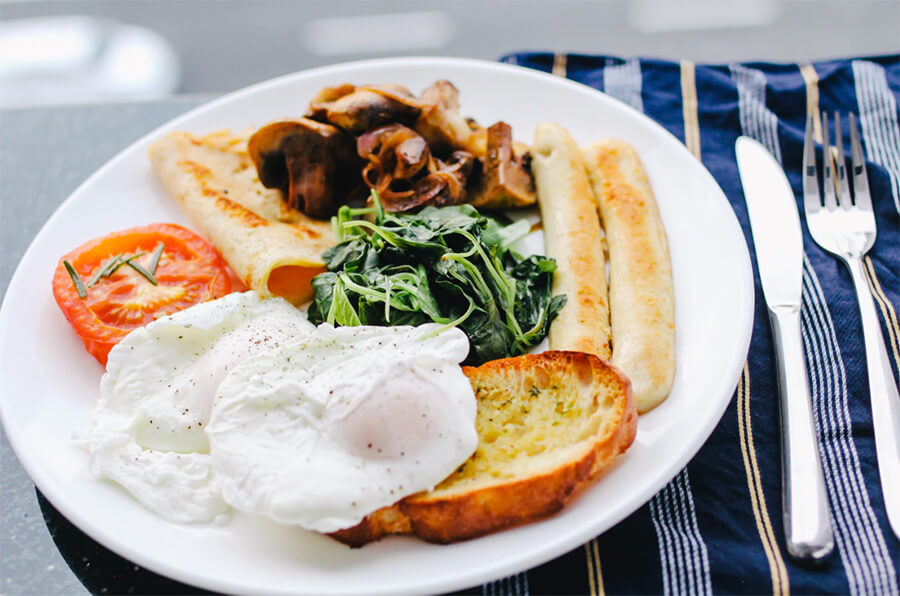
But with a content strategy to help chart your course and inform you on what to blog about, you can:
- Identify your specific ideal readers and their reasons for coming to your food blog (Do they want a specific recipe? Inspiration on mid-week dinner ideas?)
- Focus on your niche and produce engaging content that provides unique value for your readers
To create a cohesive content strategy for your food blog, walk through these steps:
- Think of your goals and what you want to achieve
- Research, understand, and learn everything about what your target readers want & need
- Identify where your audience can be found online. Are they on Instagram, Pinterest, or Facebook?
- Use keyword research to come up with content ideas and food blog post topics that your readers are looking for
- Choose the right content format like video, blog posts, infographics, or podcasts based on what your readers want most (if you do podcast though, be sure to get the best podcast hosting you can afford)
- Determine how often you’ll publish new content and be realistic & consistent once you start
- Create a content calendar so you know in advance, what topics you’re going to write about
For a real-life example of how I’m putting these best practices to work with a real food blog, check out my roundup of the best vegan breakfast burritos in Los Angeles on the Vegan Anj blog.
Want some more guidance on building out your content strategy? In my free course How to Build a Blog in 7 Days, I break this process down into an even more actionable, step-by-step checklist for you—packed with everything from finding your target audience to clever blog post ideas, my writing process, how to write blog headlines, what it takes to outline a blog post and much more.
Want my Free Course: How to Start a Profitable Blog in 7 Days?
Enter your name and email address and you’ll get instant access to my course that’s been featured on Forbes, Business Insider and Entrepreneur.
"*" indicates required fields
7. Nail your images (the best food blogs have great photography)
Ever heard the phrase that a picture is worth a thousand words?
Well, this is especially true for food blogs, because successful food blogs are very well-known as having high-quality (usually originally shot) pictures.
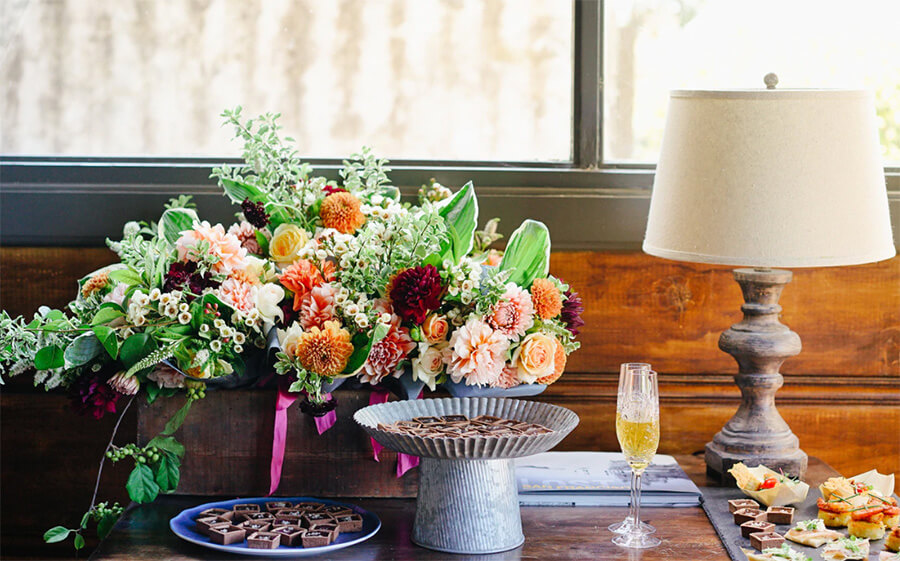
Here are some options you can use to produce stunning pictures for your food blog:
Take your own photographs (the best route)
Even if you’re not a professional photographer, you can learn to take good photographs as part of your journey in learning how to start a food blog.
Gaby of What’s Gaby Cooking is the first to admit that her photos improved only after a ton of practice (and help from other photographers).
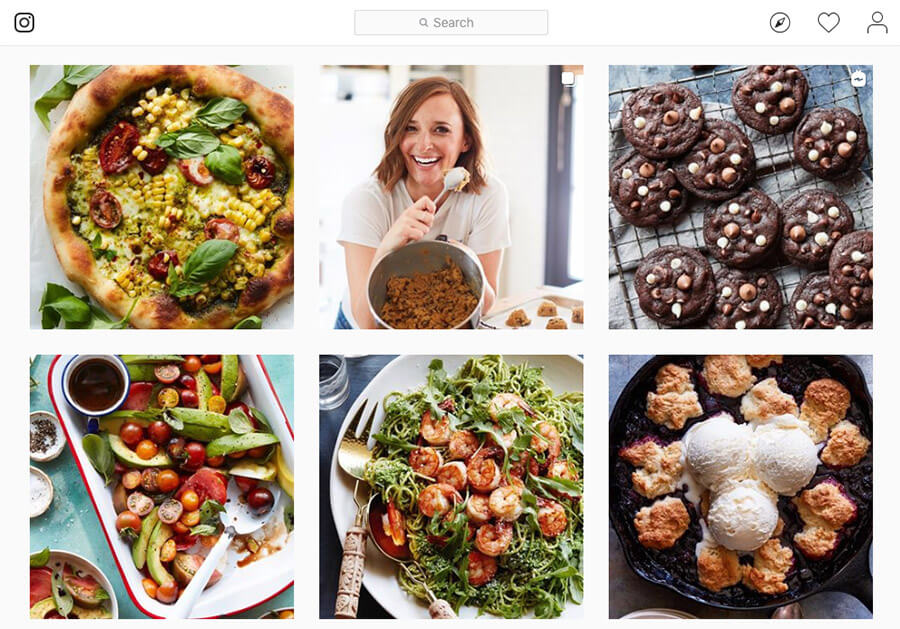
She shares this advice for new food bloggers looking to up their photography skills:
- Always use natural light to take your food photos (especially when you’re starting out)
- Move around to find the location with the best light (even if it’s outside your kitchen)
- Take pictures from different angles (from above or from the side and so on) to see what turns out best
Carefully use free stock photo libraries
You can still find beautiful pictures to use on your food blog if you’re not a professional photographer—by using free stock photos sites like Unsplash, Foodiesfeed, Pixabay, and Pexels.
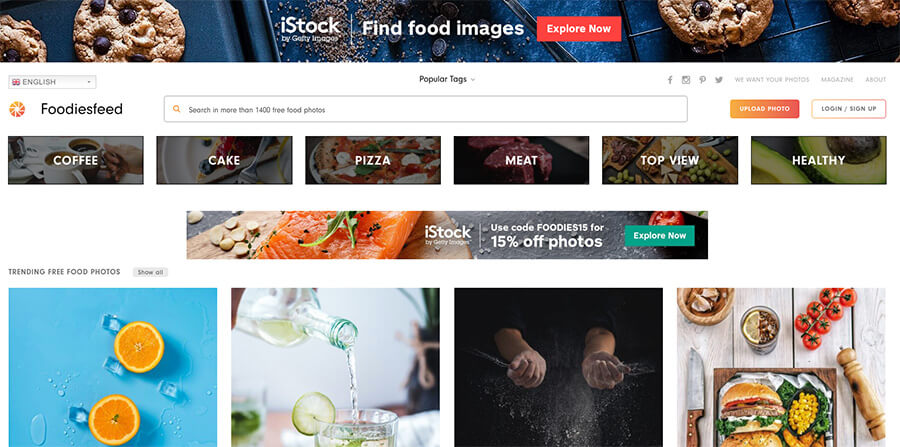
If you do though, make sure the pictures you want to use are royalty-free images that can be used for commercial purposes with no attribution required—and don’t claim that the pictures are your own.
I recommend only going this route if you’re strapped for time and financial resources in the early days of starting your food blog.
Once you’re starting to drive traffic and interact with your readers though, it’s important to make a shift to sharing your own images on your food blog for authenticity purposes.
Use free photo editing and design tools
With free photo editing and design tools, you can creatively improve the quality of your food photos even if you don’t have prior design, editing, or Photoshop skills.
Some examples of free design and photo editing tools that are perfect when learning how to start a food blog include:
Don’t forget that you can also crop and edit generic stock photos to convert them into more unique images for your own food blog with the help of these design tools.
8. Promote your food blog and network with other food bloggers
Don’t be surprised if visitors don’t magically flock to your food blog the day you start publishing content.

Let’s face it, apart from publishing content regularly, you have to actively promote your food blog—and network with other food bloggers, so you can drive more traffic back to your own food blog over the long run. It won’t happen overnight, but by focusing on these promotion channels, you’ll begin making progress right away.
Here are a few of the most proven ways to promote your food blog and build relationships with other food bloggers:
Update your email signature (to highlight your food blog)
Apart from having your contact information, website URL, and social media links in your email signature—you can also go a step further to include something like a link to your latest blog post, an email subscription link, or your latest free downloadable eBook you wrote.
Follow Gaby’s lead and focus your email signature call-to-action around what’s most important:

This is a clever way to casually promote your food blog content every time you send out an email (something you’re doing anyway)—without any additional effort.
Don’t forget to include the latest blog post headline to capture more attention and spark interest.
Get your on-page SEO right
If you want your food blog to rank high in search engine results for specific keywords in your niche (like “apple pie recipe”), then you need to get your on-page blog SEO right.
To do that, follow along with these best practices from my guide to blog SEO right here:
- Create SEO-friendly URLs (permalinks)
- Begin each food blog post title with the most important keyword phrase you want the post to rank for
- Have your keyword mentioned in the first 100 to 150 words of your content
- Boost the speed of your food blog so that pages load in 2-3 seconds or less
- Use a responsive WordPress theme so that pages load properly on all devices
- Create long-form content of high quality (that’s designed to rank well in search)
Start building an email list
With a massive 3800% return on investment, email marketing is one of the best ways to promote your content when you start a food blog.
An email list is a group of people who give you their email addresses so that they can get email updates from you when you publish new recipes, share new guides, and so on.
You can build your email list successfully when you:
- Create a high-quality lead magnet (like a free recipe book) as a gift for anyone who signs up
- Provide a subscription form on your food blog pages and in each of your blog posts
- Pick an email service provider by comparing Convertkit vs AWeber vs Mailchimp to see which is best for your needs
- Write personalized emails to develop a stronger relationship with your email subscribers
- If you need to hire some writing help, post your opportunity on one of these blogging job sites
Share your food blog posts on social media (especially Instagram)
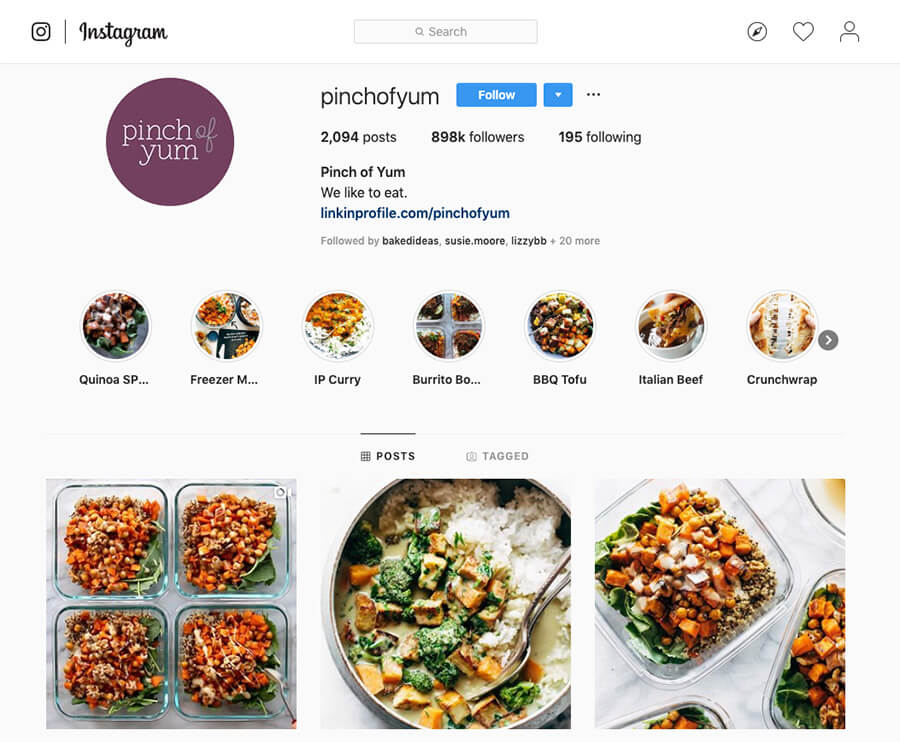
Social media can be a strong and effective promotion tool for your food posts, but there are lots of options—ranging from Instagram to Facebook, Twitter, Pinterest LinkedIn, and many more.
Instead of sharing your images frantically on every social media platform straight out the gates, identify which platform has a higher concentration of your target audience—and focus on just one or two, to start with. Even if your research produces 3 or more platforms, just start with one or two, to avoid becoming overwhelmed.
Advice from the top food bloggers suggests you should double down on Instagram and Pinterest.
To manage your time and promote your content effectively on social media, use tools like Buffer, Hootsuite, and Quuu Promote.
Remember also to include social media sharing buttons on your blog so your readers can share as well.
Write guest posts (for traffic and SEO benefits)
One of the best ways to promote your food blog, especially when you’re just starting out, is by writing guest blog posts.
Your guest posts should be published with an author bio that credits you as the author—and also provides a link back to your own food blog and social media accounts. This allows the readers of other more established food blogs (where your guest post is published) to come and follow your content too.

This makes it possible to create awareness for your food blog, drive traffic to it, and possibly even increase your email subscribers.
Don’t forget to use the following tips so you can write effective guest posts for any food blog you’re interested in publishing on:
- Take time to study the food blog before pitching (Do they accept guest posts? How are they typically formatted? Does your style match theirs?)
- Connect and develop a relationship with the food blogger or editor before pitching
- Follow any of their rules and guest posting guidelines
- Always pitch an original topic that provides value to their readers
Once your guest post goes live on the other person’s food blog, work hard to promote it on your own social media channels—they’ll likely do the same and tag you, thus helping spread awareness about your food blog on other social channels as well.
Network with other food bloggers
Another smart way to promote your content and create awareness for your food blog is to consciously build meaningful relationships with other food bloggers.
You can start laying the foundation for these relationships by taking these approaches:
- Leave thoughtful comments on their food blogs
- Share their posts on your social media channels
- Include them in your own food blog posts (then send an email to give them a heads up, they’ll probably share it)
- Send proposals to them for doing content swaps either on your food blogs or on Instagram & Pinterest
- Join free online food blogger communities like group Pinterest boards, Facebook groups, and such
- Become a member of paid membership programs for serious food bloggers like Food Blogger Pro
After that… it’s time to work on monetizing your food blog—but that’s a whole other topic 😊
However, Max Benz from kochboxguru.de, a German meal kit blog, stresses the importance of thinking about monetization early on. He shares:
“If you want to generate extra income with your food blog, you should already have an idea of how you’ll make money when you’re selecting your niche. There are several ways to earn money with a food blog (such as affiliate marketing, sponsored posts, or advertisements). For example, if you decide to use affiliate programs, you should consider applying to those programs shortly after getting started. Otherwise, they might reject your application a year down the line and your whole blogging strategy won’t quite pan out as expected.”
Final thoughts: How to start a food blog (and succeed)
Alright, now that we’ve walked through my guide on how to start a food blog… this is when the real fun begins.
Whether you want to start a food blog because you’re crazy passionate about food—or maybe you have a food business and want to blog to connect with your current customers—there’s no reason to wait any longer.
Start your food blog today and with a healthy dose of hard work, creativity, and the willingness to experiment, you’ll see results quickly.
Want my Free Course: How to Start a Profitable Blog in 7 Days?
Enter your name and email address and you’ll get instant access to my course that’s been featured on Forbes, Business Insider and Entrepreneur.
"*" indicates required fields


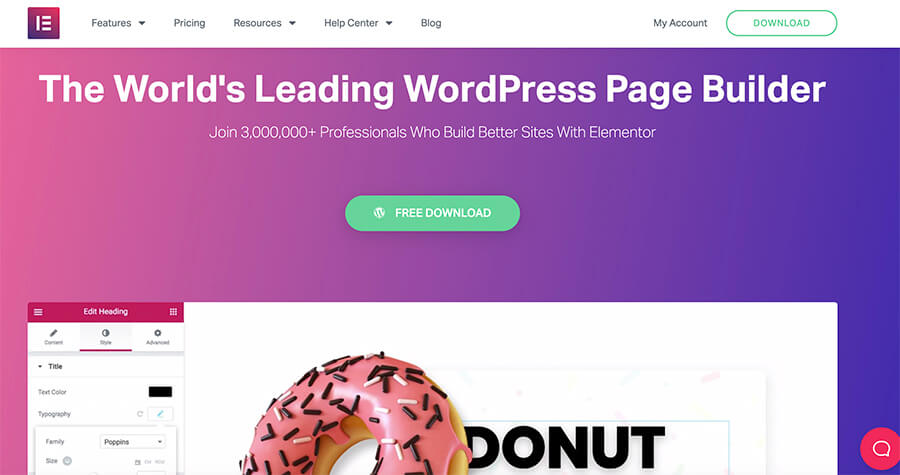

56 replies to “How to Start a Food Blog in 2025 (on the Side): Free Guide to Start Food Blogging Today”
Super helpful information – thank you! The one piece that I would love to see added here (or in a separate post) is anything surrounding the legal side of creating a food blog…such as, what types of disclaimers to use where, what legal protection is necessary/valuable, best practices when it comes to referencing, quoting or linking to other pages, content, products, etc. and any privacy concerns/safety features, etc. to be aware of, particularly with email lists, newsletters, etc. If you already have a post that addresses this all, I would love to be pointed toward it! Again – thank you very much for all of this great information!
Hey Kristin! SUCH great questions, thank you for asking them. I don’t have these specifically answered for food blogging, so what I did was went over into my AI content creation too, RightBlogger (https://rightblogger.com/) and gave it the task of writing an article on this topic… I think it turned out really well and should answer your questions pretty well. You can give that a read right here: https://share.cleanshot.com/0kyNMfxw
Thanks for sharing your blog posts.
Thank you for your delightful food blog! Your passion for cooking and sharing delicious recipes shines through in every post. Your creativity and culinary expertise have inspired me to try new dishes and experiment in the kitchen. Keep up the fantastic work, and I eagerly look forward to more mouthwatering content from your blog
Your site has enriched my life in countless ways. Thank you for sharing your expertise and making a difference.
Super helpful information – thank you! The one piece that I would love to see added here (or in a separate post) is anything surrounding the legal side of creating a food blog…such as, what types of disclaimers to use where, what legal protection is necessary/valuable, best practices when it comes to referencing, quoting or linking to other pages, content, products, etc. and any privacy concerns/safety features, etc. to be aware of, particularly with email lists, newsletters, etc. If you already have a post that addresses this all, I would love to be pointed toward it! Again – thank you very much for all of this great information!
Starting a food blog can be a very fun, rewarding, and even profitable experience as long as you’re prepared to put in the time, effort, and really learn how to start a food blog (the smart way) and organize it to its full potential.And get this, even if you just want to As a hobby food blogger, you can still make your new blog very profitable.
Your blog about starting a food blog was really helpful, and I liked it a lot.
Thank you for sharing this comprehensive guide on starting a food blog! 🍽️💼
Your step-by-step instructions and expert advice make it much easier for newcomers to take the plunge into the world of food blogging. As someone who’s dedicated to providing support for food bloggers and content creators, I can truly appreciate the value of your insights.
For those looking to enhance their food blogging journey, I encourage you to explore my website Content for Food Bloggers. We specialize in offering budget-friendly content solutions, including recipe packs, SEO guides, and more, designed to help you succeed while being mindful of your budget.
Your post is an excellent starting point, and when combined with our resources, food bloggers can set themselves up for success from day one. Keep up the fantastic work in empowering the food blogging community!
Are services of wordpress and bluehost available outside US?
Absolutely!
Super helpful information – thank you!